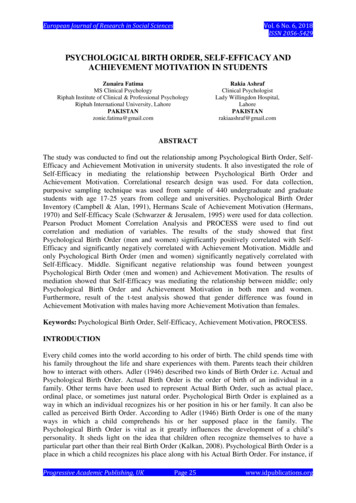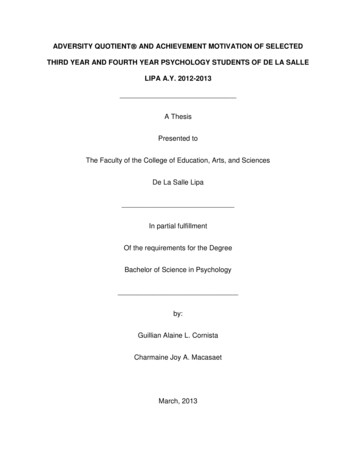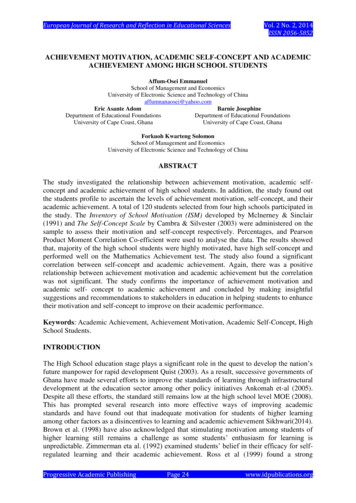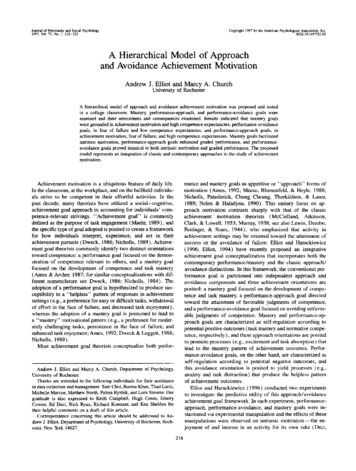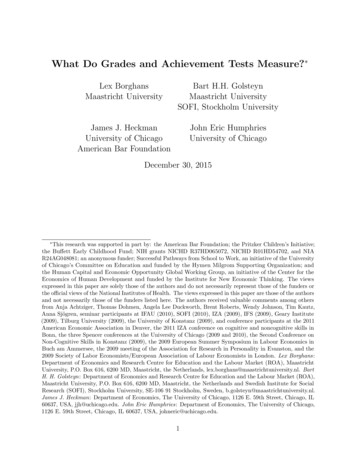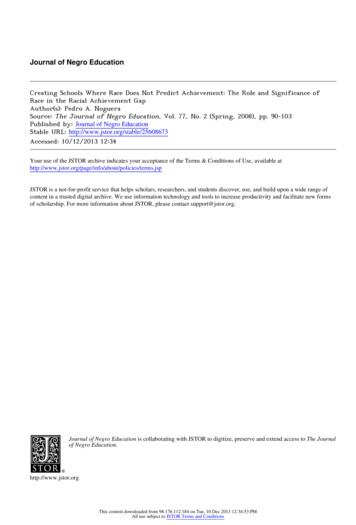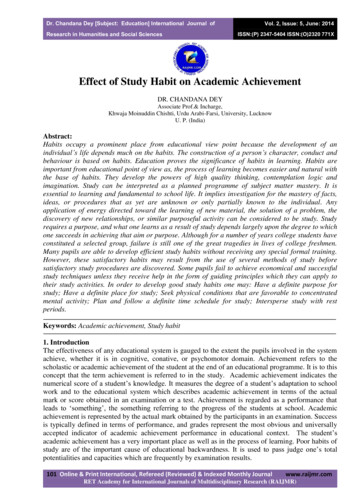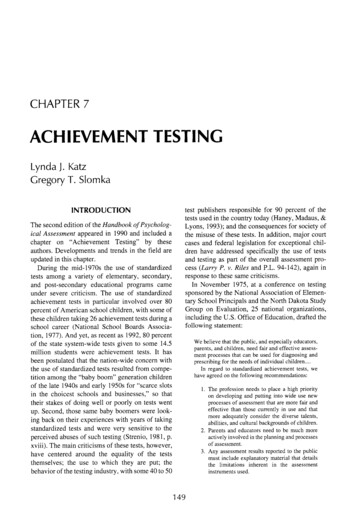
Transcription
CHAPTER 7ACHIEVEMENT TESTINGLynda J. KatzGregory T. SlomkaINTRODUCTIONtest publishers responsible for 90 percent of thetests used in the country today (Haney, Madaus, &Lyons, 1993); and the consequences for society ofthe misuse of these tests. In addition, major courtcases and federal legislation for exceptional children have addressed specifically the use of testsand testing as part of the overall assessment process (Larry P. v. Riles and P.L. 94-142), again inresponse to these same criticisms.In November 1975, at a conference on testingsponsored by the National Association of Elementary School Principals and the North Dakota StudyGroup on Evaluation, 25 national organizations,including the U.S. Office of Education, drafted thefollowing statement:The second edition of the Handbook of Psychological Assessment appeared in 1990 and included achapter on "Achievement Testing" by theseauthors. Developments and trends in the field areupdated in this chapter.During the mid-1970s the use of standardizedtests among a variety of elementary, secondary,and post-secondary educational programs cameunder severe criticism. The use of standardizedachievement tests in particular involved over 80percent of American school children, with some ofthese children taking 26 achievement tests during aschool career (National School Boards Association, 1977). And yet, as recent as 1992, 80 percentof the state system-wide tests given to some 14.5million students were achievement tests. It hasbeen postulated that the nation-wide concern withthe use of standardized tests resulted from competition among the "baby boom" generation childrenof the late 1940s and early 1950s for "scarce slotsin the choicest schools and businesses," so thattheir stakes of doing well or poorly on tests wentup. Second, those same baby boomers were looking back on their experiences with years of takingstandardized tests and were very sensitive to theperceived abuses of such testing (Strenio, 1981, p.xviii). The main criticisms of these tests, however,have centered around the equality of the teststhemselves; the use to which they are put; thebehavior of the testing industry, with some 40 to 50We believe that the public, and especially educators,parents, and children, need fair and effective assessment processes that can be used for diagnosing andprescribing for the needs of individual children .In regard to standardized achievement tests, wehave agreed on the following recommendations:1. The profession needs to place a high priorityon developing and putting into wide use newprocesses of assessment that are more fair andeffective than those currently in use and thatmore adequately consider the diverse talents,abilities, and cultural backgrounds of children.2. Parents and educators need to be much moreactively involved in the planning and processesof assessment.3. Any assessment results reported to the publicmust include explanatory material that detailsthe limitations inherent in the assessmentinstruments used.149
150HANDBOOK OF PSYCHOLOGICAL ASSESSMENT4. Educational achievement must be reported interms broader than single-score nationalnorms, which can be misleading.5. Information about assessment processesshould be shared among the relevant professions, policy makers, and the public so thatappropriate improvements and reforms can bediscussed by all parties.6. Every standardized test administered to a childshould be returned to the school for analysis bythe teachers, parents, and child.7. Further, the standardized tests used in anygiven community should be made publiclyavailable to that community to give citizens anopportunity to understand and review the testsin use.8. The professions, the public, and the medianeed to give far greater consideration to theimpact of standardized testing on children andyoung people, particularly on those below theage of ten.9. A comprehensive study should be conductedon the actual administration and use of standardized tests and the use of test scores in theschools today. (National School Boards Association, 1977, p. 18).In 1983 A Nation at Risk was published, one ofthe most widely publicized education reformsreports of the 1980s. In that report the authorswarned "the educational foundations of our societyare presently being eroded by a rising tide of mediocrity that threatens our very future as a nation anda people" (p. 5).The National Commission on Excellence inEducation went on to recommend that "standardized tests of achievement (not to be confused withaptitude tests).be administered at major transitionpoints from one level of schooling to another andparticularly from high school to college or work"(p. 28). The purposes of testing would be to certifya student's credentials, identify needs for remedialinstruction and identify opportunities for accelerated work.In 1990, U.S. President Bush and the NationalGovernors Association announced the "America2000" strategy for educational reform (NationalEducation Goals Panel, 1990). That reform calledfor new achievement tests in the core subjects ofEnglish, mathematics, science, history, and geography. These tests were to differ from traditionalnorm-referenced assessments and focus instead onproblem solving or task performance. The authorof one recent review article has suggested thatover-reliance on multiple-choice tests in the 1980s"led teachers to emphasize tasks that would reinforce rote learning and sharpen test-taking skills,and discouraged curricula that promote complexthinking and active learning (Wells, 1991, p. 55).In addition, the Individuals with Disabilities Act(IDEA) of 1990 (Amendments to the Education forall Handicapped Children Act of 1975) called specifically for nondiscriminatory testing and multidisciplinary assessment (Hardman, Drew, Egan, &Wolf, 1993) for children with disabilities, explicitly supporting a major role for testing in the Individual Educational Plan (IEP). It has beenestimated that between 8 and 20 million tests wereused for special-education testing alone in the late1980s (Haney, Madaus & Lyons, 1993). Theseestimates are based on 4.4 million students aged 3to 21 years who served in special education programs in elementary and secondary schoolsbetween 1984 and 1985 (Snyder, 1987), and forwhom an average of five to ten tests were used forinitial assessment and one to two tests were used atleast every three years thereafter. The majority ofthese tests were tests of achievement.Thus, it remains both relevant and timely morethan a decade later to review the historical development, classification, and psychometric properties of traditionalachievement tests; update their status and use in terms of contemporary educational and clinical research and practice; consider the relationship of achievement testingto ecological and sociocultural, variables andtheir use with special population groups; and take a futuristic look at the impact of moderncomputer technology on test construction andutilization.Such a discussion may determine whether recommendations made 20 years ago regarding theuse of achievement tests have been or will continueto need to be addressed.Historical Development ofAchievement TestsThe standardized objective achievement testbased on a normative sample was first developedby Rice in 1895. His spelling test of 50 words (withalternate forms) was administered to 16,000 students in grades 4 through 8 across the country.Rice went on to develop tests in arithmetic and language, but his major contribution was his objective
ACHIEVEMENT TESTINGand scientific approach to the assessment of student knowledge (DuBois, 1970). Numerous othersingle-subject-matter achievement tests weredeveloped in the first decade of the twentieth century, but it was not until the early 1920s that thepublication of test batteries emerged; in 1923, theStanford Achievement Test at the elementarylevel, and in 1925, the Iowa High School ContentExamination (Mehrens & Lehmann, 1975). Sincethe 1940s, there has been a movement toward testing in broad areas as well, such as the humanitiesand natural sciences rather than in specialized, single-subject-matter tests. Moreover, attention hasbeen directed toward the evaluation of work-studyskills, comprehension, and understanding, ratherthan factual recall per se. In the 1970s, standardized tests were developed that were keyed to particular test books, the use of "criterion-referenced"tests (CRTs) emerged (their dissimilarity fromnorm-referenced tests will be addressed in the nextsection), and the development of "tailored-to-userspecifications" tests (Mehrens & Lehmann, 1975,p. 165) was initiated.Early in the 1990s, the literature on achievementtesting was concerned with latent-trait theory,item-response curves, and an assessment of learning achievement that is built into the instructionalprocess. With the later 1990s, concerns havetended to focus on the intrinsic nature of theachievement test itself. Computer-adaptive testingis not the computerization of standardized normreferenced paper-and-pencil tests but a radicallydifferent approach. The approach is based on aconcept of a continuum of learning and where aparticular child fits on that continuum so that his orher experience with testing is one of success ratherthan failure.In addition to computer-adapted testing, the useof alternative assessment tools has taken a frontrow seat (Improving America's Schools, Spring,1996). This performance based assessmentapproach involves testing methods that require students to create an answer or product that demonstrates knowledge or skill (open-ended orconstructed-response items, presentations, projectsor experiments, portfolios). As Haney & Madaus(1989) have pointed out, these alternatives to multiple-choice tests are not new; and in fact, multiplechoice testing replaced these alternative forms ofassessment in the late 19th and early 20th centuriesbecause of the expense involved, the difficultieswith standardization, and their use with large numbers of people. To appreciate fully this dramatic1 51shift in the conceptualization of the assessment ofachievement, it is first necessary to understand (a)the nature of tests which fall under the domain ofachievement; (b) the psychometric underpinningsof achievement tests; (c) the basis for criterion-referenced as opposed to norm-referenced measurement; and (d) special issues which arise whenachievement tests are used for particular purposes.Classification of Achievement TestsAchievement tests have generally been categorized as single-subject tests, survey batteries, ordiagnostic tests and further dichotomized as groupor individually administered tests. Reference to theNinth Mental Measurement Yearbook (Mitchell,1985) reveals the prevalence of multitudinous published objective tests, and elsewhere it has beenreported that some 2,585 standardized tests are inuse (Buros, 1974). Table 7.1 is a listing of the mostcommonly used achievement tests. They have beencategorized as (a) group administered, (b) individually administered, and (c) modality-specific testsof achievements, which can be either group orindividually administered.Typically one administers achievement tests inorder to obtain an indication of general academicskill competencies or a greater understanding of anindividual's performance in a particular area ofacademic performance. In this regard achievementtests are specifically designed to measure "degreeof learning" in specific content areas. There areseveral distinct applications of achievement testswhich vary as a function of the setting in whichthey are applied. Tests such as the MetropolitanAchievement Tests, Stanford Achievement Tests,California Achievement Tests, and Iowa Tests ofBasic Skills represent instruments that typicallyconsist of test-category content in six or more skillareas. The benefit of the battery approach is that itpermits comparison of individual performancesacross diverse subjects. Because all of the contentareas are standardized on the same population, differences in level of performance among skill areascan reflect areas of particular strength or deficit.Many of these instruments provide a profile as wellas a composite score that allows ready comparisonof levels of performance between tests. The representative content of these batteries typicallyincludes core assessment of language, reading, andmathematics abilities. The extensiveness of thecoverage of allied curricula, that is, science,
152HANDBOOK OF PSYCHOLOGICAL ASSESSMENTTable 7.1. Commonly Used Achievement TestsGroup Administered Achievement TestsCalifornia AchievementTestsCTB/McGraw Hill (1984). California Achievement Tests. Monterey, CA: Author.Iowa Test of Basic SkillsHieronymus, E. F., Lindquist, H. D., & Hoover, D., et al. (1978). Iowa Test of Basic Skills.Chicago: Riverside Printing.Metropolitan AchievementTestBalow, I. H., Farr, R., Hogan, T. P., & Prescott, G. A. (1978). Metropolitan AchievementTests (5th ed.). Cleveland, OH: Psychological Corporation.Stanford Achievement TestGardner, E. G., Rudman, H. C., Karlson, B., & Merwin, J. C. (1982). StanfordAchievement Test. Cleveland, OH: Psychological Corporation.SRA Achievement Services(SPA)Naslond, R. A., Thorpe, L. P. & Lefever, D. W. (1978). SRA Achievement Series, Chicago:Science Research Associates.Individually Administered Achievement TestsPsychological Corporation (1983). Basic Achievement Skills Individual Screener. SanBasic Achievement SkillsAntonio: Author.Individual Screener (BASIS)Kaufman Test of EducationalAchievementKaufman, A. S., & Kaufman, N. G. (1985). Kaufman Test of Individual Achievement,Circle Pines, MN: American Guidance Service.Peabody IndividualAchievement Test-RevisedMarkwardt, F. C. (1989). Peabody Individual Achievement Test. Circle Pines, MN:American Guidance Services.Wide Range AchievementTest 3Wilkinson, G. S. (1993). Wide Range Achievement Test 3. Wilmington, DE:Jastak Associates.Woodcock JohnsonPsychoeducational BatteryRevisedWoodcock, R. W. (1989). Woodcock Johnson Psychoeducational Battery-Revised:Technical Report. Allen, TX: DLM Teaching Resources.Modality Specific Achievement TestsReadingSilvaroli, N. J. (1986). Classroom Reading Inventory (5th ed.). Dubuque, IA: Wm. C.Classroom ReadingBrown.InventoryDiagnostic Reading ScalesSpache, G. D. (1981). Diagnostic Reading Scales. Monterey, CA: CTB/McGraw-HilI.Durrell Analysis ofReading DifficultyDurrell, D. D., & Catterson, J. H. (i 980). Durreli Analysis of Reading Difficulty (3rd ed.).Cleveland, OH: Psychological Corporation.New Sucher-AIIred ReadingPlacement SurveySucher, F., & AIIred, R. A. (1981). New Sucher-AIIred Reading Placement Inventory.Oklahoma City: Economy Company.Gates-MacGinitie ReadingTestsMacGinitie, W.H., et al. (1978). Gates-MacGinitie Reading Tests. Chicago:Riverside Publishing.Gray Oral Reading TestsWiederholt, J. L., Bryant, B. R. (1992). Gray Oral Reading Tests, Third Edition.Austin, TX: Pro-Ed.Nelson-Denny Reading TestBrown, J.l., Fishco, V.V., & Hanna, G. (1993). Nelson-Denny Reading Test. Chicago:Riverside Publishing Co.Stanford Diagnostic ReadingTestKarlson, B., Madden, R., & Gardner, E. F. (1976). Stanford Diagnostic Reading Test(1976 ed.). Cleveland, OH: Psychological Corporation.Woodcock Reading MasteryTests-RevisedWoodcock, R. W. (1987). Woodcock Reading Mastery Tests-Revised. Circle Pines, MN:American Guidance Service.(continued)
ACHIEVEMENT TESTING15 3Table 7.1. (Continued)MathematicsEnright Diagnostic Inventoryof Basic Arithmetic SkillsEnright, F. E. (1983). Enright Diagnostic Inventory of Basic Arithmetic Skills; North Billerica, MA: Curriculum Associates.Keymath RevisedConnolly, A. J. (1988). Keymath Revised. A Diagnostic Inventory of Essential Mathematics. Circle Pines, MN: American Guidance Service.Sequential Assessment ofMathematics InventoriesReisman, F. K. (1985). Sequential Assessment of Mathematics Inventories, San Antonio,TX: Psychological Corporation.Stanford DiagnosticMathematics TestBeatty, L. S., Madden, R., Gardner, E. G., & Karlsen, B. (1976). Stanford DiagnosticMathematics Test. Cleveland, OH: Psychological Corporation.Test of MathematicalAbilitiesBrown, V. L., Cronin, M. E., & McEntire, E. (1994). Test of Mathematical Abilities, Second Edition. Austin, TX: PRO-ED.LanguageSpellmasterGreenbaum, C. R. (1987). Spellmaster. Austin, TX: Pro-Ed.Test of Written Language-3Hammill, D. D., Larsen, S.C. (1996). Test of Written Language, Third Edition. Austin,TX: Pro-Ed.Woodcock LanguageProficiency Battery- RevisedWoodcock, R.W. (1991). Woodcock Language Proficiency Battery-Revised. English andSpanish Forms. Chicago: The Riverside Publishing Company.Written LanguageAssessment TestGrill, J. J., & Kerwin, M.M. (1989). Written Language Assessment Test. Novato, CA: Academic Therapy Publications.humanities, and social studies, varies significantly.Sax (1974) provides a description of the major differentiating characteristics of 10 of the most commonly used achievement test batteries.In contrast to the "survey" type tests or screening batteries described above are the more contentfocused diagnostic achievement tests. Althoughany of the survey instruments is available to identify areas of academic strength or weakness(Radencich, 1985), they are not in themselves sufficient for diagnostic or remediation-planning purposes. Their use in screening large groups helps toidentify those individuals in need of more specificindividualized diagnostic evaluation. Through theuse of a diagnostic battery, an area of identifieddeficit is examined in a more extensive fashion todetermine what factors contribute to the academicdysfunction. Typically, these tests include a broadenough sampling of material so that areas of needare specified in order to develop remedial instructional objectives. For example, the WoodcockReading Mastery Tests-Revised (Woodcock,1987) provides five subtests which examine component processes associated with overall readingability. These include Letter Recognition, WordAttack, Word Recognition, Word Comprehension,and Passage Comprehension. More in-depth exam-ination at this level permits hypothesis generationregarding the nature of the specific academic deficit to be further tested. Similar tests are available toassess other aspects of academic performance:mathematics, spelling, writing, language skills,etc. Refined assessment at this level is necessaryfor differential diagnosis and remedial intervention. Screening batteries simply do not permit sufficient evaluation of an area for this kind ofdecision making to take place.Although most achievement tests have thepotential to be used as screening instruments toidentify individuals in need of remedial instruction, fewer instruments actually appear to havebeen used for diagnostic purposes. In a nationalsurvey conducted in the early 1980s, Goh, Teslow,and Fuller (1981) reported that the Wide RangeAchievement Test and the Peabody IndividualAchievement served as the general achievementbatteries most commonly utilized by school psychologists. At that point in time, in the area of specific achievement tests, the Key Math DiagnosticAchievement Test, the Illinois Test of Psycholinguistic Abilities (ITPA), and the Woodcock Reading Mastery Tests ranked as the instruments usedmost frequently for the assessment of specific academic content areas. However, in the late 1990s,
154HANDBOOK OF PSYCHOLOGICAL ASSESSMENTone rarely, if ever, encounters reference to theITPA either in reported research studies or in diagnostic test reports used as part of an IndividualizedEducation Plan.Criterion-Referenced versusNorm-Referenced Achievement TestsOne other highly significant dichotomy must beaddressed when discussing the classification ofachievement tests and certain of their psychometric properties, namely, the distinction between criteflon-referenced tests (CRTs) and normreferenced tests (NRTs). While it is not possible todifferentiate one from the other in terms of visualinspection (a criterion-referenced test can also beused as a norm-referenced test: for example, BasicAchievement Skills Individual Screener), there areintrinsic differences between the two approachesto achievement testing. Traub and Rowley (1980)described the decade of the 1970s as a time when"the notion of criterion-referenced measurementcaptured and held the attention of the measurementprofession unlike any other idea" (p. 517). Mehrens and Lehmann (1975) asserted that the issuesof accountability, performance contracting, formative evaluation, computer-assisted instruction,individually prescribed instruction, and masterylearning created a need for a new kind of test, thecriterion-referenced test.The concept of criterion-referenced achievement measurement was first detailed in the 1963paper by Robert Glaser entitled "InstructionalTechnology and the Measurement of LearningOutcomes: Some Questions." In that landmarkpublication Glaser wrote:Underlying the concept of achievement is the notionof a continuum of knowledge acquisition rangingfrom no proficiency at all to perfect performance. Anindividual's achievement level falls at some point onthis continuum as indicated by behaviors he displaysduring testing. The degree to which his achievementresembles desired performance at any specified levelis assessed by criterion-referenced measures ofachievement or proficiency. Criterion levels can beestablished at any point in instruction .Criterion-referenced measures indicate the content of the behavioral repertory . Measures whichassess student achievement in terms of a criterionstandard.provide information as to the degree ofcompetence attained by a particular student which isindependent of reference to the performance of others. (p.519)Glaser further stated that achievement measuresare appropriately used to provide informationregarding a student's capability in relation to thecapabilities of his or her fellow students as well.Where an individual's relative standing along thecontinuum of attainment is the primary concern,the appropriate achievement measure is one that isnorm referenced. Whereas both CRTs and NRTsare used to make decisions about individuals,NRTs are usually employed where a degree ofselectivity is required by a situation, as opposed tosituations in which concern is only with whether anindividual possesses a particular competence andthere are no constraints regarding how many individuals possess that skill. Thus, at the core of thedifference between the two kinds of tests is theissue of variability. "Since the meaningfulness of anorm-referenced score is basically dependent onthe relative position of the score in comparisonwith other scores, the more variability in the scoresthe better" (Popham, 1971). This obviously is not arequirement of the criterion-referenced measure.Because of basic differences in the theoriesunderlying test construction, there have been several hundred publications on CRTs dealing withsuch issues as test reliability, determination of testlength (Millman, 1973), score variability (Hambleton & Cignor, 1978; Hambleton, 1980), and testvalidity (Linn, 1982). The psychometric propertiesof CRTs have undergone close scrutiny, and one ofthe most critical dimensions reviewed has been theissue of validity. In the words of Linn (1980):Possibly the greatest short-coming of criterion-referenced measurement is the relative lack of attentionthat is given to questions of validity of the measures.The clear definitions of content domains and wellspecified procedures for item generation of some ofthe better criterion-referenced measures place thecontent validity of the tests on much firmer groundthan has been typical of other types of achievementtests. Content validity provides an excellent foundation for a criterion-referenced test; but.more isneeded to support the validity of inferences and usesof criterion-referenced tests. (p. 559)In their review of 12 commercially prepared criterion-referenced tests, Hambleton and Cignor(1978) did not find a single one that had a test manual that included satisfactory evidence of validity(Hambleton, 1980). Validity has too often beenassumed by both developers and users of criterionreferenced tests. This is no more acceptable for acriterion-referenced test than it is for any other test.It is time that questions of validity of the uses and
ACHIEVEMENT TESTINGinterpretations of criterion-referenced tests begiven the attention they deserve.Despite these criticisms from the point of viewof traditional test-construction theory, criterionreferenced measurement has been found to havemajor utility with respect to the development ofcomputer-assisted, computer-managed, and selfpaced instructional systems. In all of these instructional systems, testing is closely allied with theinstructional process, being introduced before, during, and after the completion of particular learningunits as a monitoring, diagnostic, and prescriptivemechanism (Anastasi, 1982). Moreover, it has hadpractical applications with respect to concerns withminimum competency testing (Hunter & Burke,1987; Lazarus, 1981) and mastery testing (Harnisch, 1985; Kingsbury & Weiss, 1979).Curriculum-Based MeasurementIn addition to criterion-referenced and norm-referenced tests of achievement, one additional"hybrid"mwhich appears to be surfacing, particularly in the area of special educationmcurriculumbased measurement (CBM), merits a brief note inthis review. From the Institute for Research onLearning Disabilities at the University of Minnesota, Deno (1985) and his colleagues have proposed a method of measurement which liessomewhere between the use of commercializedtests and informal teacher observations. Their initial research with the procedure in the areas ofreading, spelling, and written expression, and concerns with reliability, validity, and limitations arereviewed by Deno. Among the limitations are itsutility only with the domain of reading at present,its lack of stability estimates as indicative of reliability, and its lack of generality that enablesaggregation across curricula.However, one aspect of CBM that appears tomark a distinct embarkation from traditionalachievement testing is the concept of frequentmeasurement. In addition to the work of Mirkin,Deno, Tindal, and Kuehnle (1982) on the measurement of spelling achievement with learning disabled students, LeMahieu (1984) reported on theextensive use of a program of frequent assessmentknown as the Monitoring Achievement in Pittsburgh (MAP) which began in 1980 and involved81 schools with a total enrollment of 40,000 students. Students were tested every six weeks withcurriculum-based measures developed by commit-155tees of teachers. Serious risks in this kind ofachievement testing involve the potential forteachers to narrow the curriculum and to teach tothe assessment instrument as well as for studentsthemselves to develop and refine test-wise behaviors as opposed to attaining specific academicskills.USE OF ACHIEVEMENT TESTSAchievement Tests in EducationWithin the context of educational programsthere is a continual process of evaluation that alsoincludes teacher-made tests and letter-grade performance standards. The continuous monitoring ofstudent performance within a particular academiccontent area provides means not only to assess student progress but also to link instructional strategies and learning objectives with identified studentlearning needs or skill deficits. Out of a concern forthe performance of public schools, statewide minimum competency testing programs proliferated inthe 1990s. "Policymakers reasoned that if schoolsand students were held accountable for studentachievement, with real consequences for those thatdidn't measure up, teachers and students would bemotivated to improve performance" (ImprovingAmerica's Schools, 1996, p. 1). Traditionalachievement tests were judged to be "low-end"tests (p.1), and the advent of standards-basedreform was seen as impetus to revamp methods ofstudent assessment, a revamping which is ongoingat the time of this writing.In a similar vein, a study by Herman, Abedi, andGolan (1994) assessed the effects of standardizedtesting on schools. They surveyed 341 elementaryteachers in 48 schools, although the location of theschools was not identified. In their study, classes inwhich disadvantaged students were the majoritywere more affected by mandated testing than thoseserving their more advantaged peers. Results suggested that teachers serving disadvantaged students were under greater pressure to improve testscores and more driven to focus on test content andto emphasize test preparation in their instructionalprograms.Despite such criticisms with respect to themisuse or inappropriate use of these tests, theperiodic administration of achievement tests hastraditionally been viewed as an educationally
156HANDBOOK OF PSYCHOLOGICALASSESSMENTTable 7.2.Achievement Tests: Purpose and OutcomePURPOSE OF TESTINGOUTCOME fication of students potentially eligible for remedial programming.Specific academic deficiencies have been ascertained. Question now arises regardingwhether student meets eligibility criteria.Prescriptive Intervention: A specific developmental arithmetic disorder is manifest in a child identified withvisuo-perceptual processing problems. What curriculum adjustments appear warranted?Program Evaluation:Administrators seek to evaluate benefits of an accelerated reading program for gifted students.sound procedure by professionals in the field.From a positive perspective, Anastasi (1988)provided a summary of their usefulness in educational settings. First, their inherent objectivity and uniformity provide an important tool inassessing the significance of grades. While individual classroom-performance measures can besusceptible to fluctuation because of a numberof variables, their correlation with achievementtest scores provides a useful comparative validity criterion
ACHIEVEMENT TESTING Lynda J. Katz Gregory T. Slomka INTRODUCTION The second edition of the Handbook of Psycholog- ical Assessment appeared in 1990 and included a chapter on "Achievement Testing" by these authors. Developments and trends in the field are updated in this chapter. .

